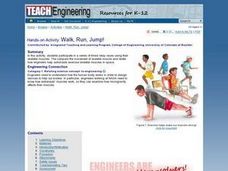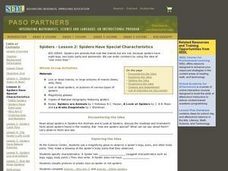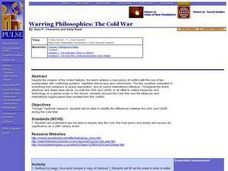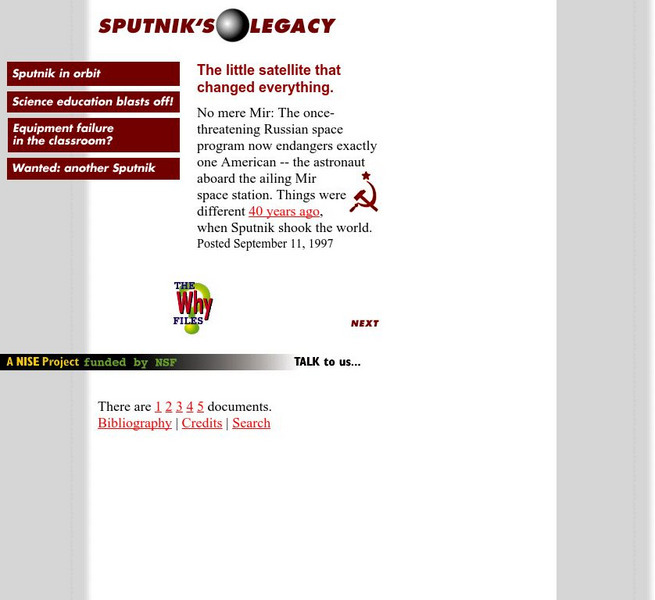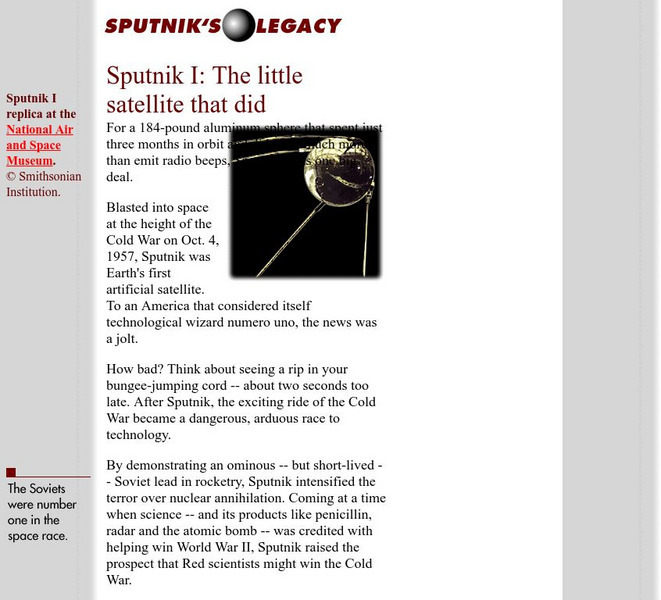Curated OER
Walk, Run, Jump!
Learners participate in a series of timed relay races using their skeletal muscles. They compare the movement of skeletal muscle and relate how engineers help astronauts exercise skeletal muscles in space. They list the three types of...
Curated OER
Spiders Have Special Characteristics
Students state reasons why spiders are grouped in specific categories, including what distinguishes a spider from an insect. They report on their observations of the spiders. They illustrate their report with drawings in their journals.
Curated OER
Reading: An Amazing Swimsuit
For this inventions worksheet, students read a one page text about the new type of swimsuit used in the 2008 Beijing Olympics called the Speedo LZR Racer. Students answer 10 true or false questions about the passage.
Curated OER
Warring Philosophies: The Cold War
Young scholars explain why the Cold War took place and ended. They analyze its significance as a 29th century event. Students identify the differences between the USA and USSR during the Cold War.
Curated OER
Chapter 10: Racial and Ethnic Relations
In this racial and ethnic relations in America worksheet, students answer 15 matching questions and respond to 7 short answer questions regarding various racial and ethnic groups terms and issues in U.S. society.
Curated OER
Our Eye in the Sky: The TIROS Weather Satellite
Students investigate the political context of the creation of a weather satellite. In this technology and society lesson, students explore the historical, technological, and political context of the TIROS weather satellite. They write a...
Curated OER
The Planets Moon
Students explore the theories of the creation of the universe and examine the properties of celestial bodies. They analyze the relationship between the sun, Earth and other planets. They discover the infinite potential of the science of...
Curated OER
Developing a Media Portfolio
students discuss the vehicles used by media to feed images to consumers. In small groups, 9th graders are given magazines and asked to pick out the ads that appeal to them. They write responses to the questions:
Curated OER
The New Deal
Young scholars investigate the history behind The New Deal through using primary source documents. This allows students to discover history with limited background knowledge. They answer questions and receive further clarification with...
Curated OER
GPS Receiver Basics
Students practice using a GPS receiver. They walk in different directions and monitor their progress on maps. They enter specific locations and use information given to them to get them back to their original locations.
White House Historical Association
White House Historical Association: John F. Kennedy and the Space Race
A look at John F. Kennedy's goal for the United States, which was to send the first man to the Moon and to bring him safely back to Earth. Informational text and lesson plan for students in grades 9-12.
TED Talks
Ted: Ted Ed: Who Won the Space Race?
Jeff Steers describes the history and benefits of the space race between the United States and the Soviet Union. [4:47]
Other
Historic Wings: "One Small Step" Race to the Moon
"One Small Step, The Race To The Moon" is a clear presentation of the story of the Moon landing program that the United States conducted during the 1960's and early 1970's. After launching the presentation click on the phases of the Moon...
Curated OER
National Park Service: America's Space Program Exploring a New Frontier
This site includes a lesson for teachers to use when teaching about America's space program. Also included is the history of the space program, maps, readings, images of the space program, and benefits that resulted from space research.
Siteseen
Siteseen: American Historama: The Space Race
Provides interesting facts and an overview of the Cold War Space Race (1957-1975), a competition in the exploration of space between the United States and the Soviet Union.
Ducksters
Ducksters: The Cold War for Kids: Space Race
Kids learn the history of the Space Race during the Cold War. A race between the United States and the Soviet Union to put a man on the Moon.
Smithsonian Institution
National Museum of American History: Teaching Math & Science in Age of Sputnik
Why did the Soviet Union's launch of Sputnik throw the fields of mathematics and science into tremendous demand in the United States? Find the many ways this revolutionary event impacted children from the 1950s to become the...
University of Wisconsin
The Why Files: Sputnik's Legacy
This exploratory article (published September 11, 1997) outlines the history of the Sputnik Space program, but also includes the response within the United States educational system to speedily ramp up the study of science, math and...
University of Wisconsin
The Why Files: Sputnik's Legacy
Easy-to-read history of the Soviet satellite launch that began the race for space between the Soviet Union and United States. Click on "next" at the bottom to advance to the next page.


